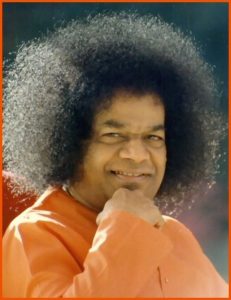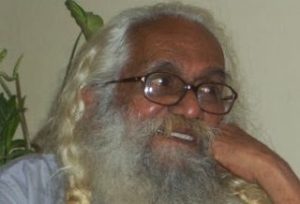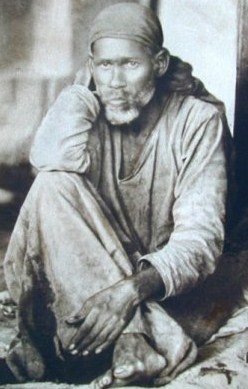
Sathya Sai Baba
In 1998, Professor Tulasi Srinivas commenced a lengthy nine year ethnographic study of the movement in the name of Sathya Sai Baba (d.2011). Her book is classified under anthropology. She emphasises the theme of globalisation, viewed by some analysts in terms of Western capitalist dominance. In 1989 the Indian economy was opened to global market forces; a new middle class emerged with affluent purchasing power (Srinivas, Winged Faith, 2010, pp. 1-2).
In 1950, Sathya Sai Baba established an ashram at the village of Puttaparthi, in a rural zone of Andhra Pradesh, about a hundred miles from the city of Bangalore. His biography is a problem. “Devotee accounts construct a complete and complex mythic biography that replaces lost incidents in his life” (Srinivas 2010:52). The hagiology involved is notorious amongst scholars, one of whom observed over twenty years ago that “no objective account of Sathya Sai Baba’s life has been written by anyone close to him” (Srinivas 2010:53, citing L. Babb, 1987). There are hundreds of devotional biographies, a very few of which are officially favoured by the sect.
It is definite that, at an early stage in his career, Sathyanarayana Raju claimed to be a reincarnation of Sai Baba of Shirdi (d.1918). This development occurred in the 1940s. The youthful claimant “demanded that people refer to him as Sathya Sai” (Srinivas 2010:57). Confusions about the supposed predecessor (Shirdi Sai) are rife in many accounts, including those written by academics. Sathya Sai claimed to materialise healing ash (vibhuti). The “miraculous” association has mistakenly been applied to Shirdi Sai, “who had also materialised vibhuti for his followers” (Srinivas 2010:9). That statement is erroneous, derived from assumptions found in sectarian literature. Cf. Shepherd 2005:2-58; Shepherd 2015:398-399.
Shirdi Sai Baba
Sai Baba of Shirdi was a liberal Muslim Sufi faqir who lived at a simple rural mosque in Maharashtra. He became subject to Hinduising hagiological tendencies, which could not, however, completely eclipse the original profile that is evident to close analysis (Warren 1999, 2004; Shepherd 2015). Shirdi Sai requires to be carefully distinguished from Sathya Sai, despite the conflatory tendencies that became popular in some directions.
The Puttaparthi ashram became very wealthy, a process aided by the reincarnation claim, by the display of “miracles,” and by the many visitors from Western countries. Another explanation is: “The [Sathya] Sai religious movement can be construed as a global religious empire” (Srinivas 2010:235ff.). One development was the Sathya Sai (Seva) Organisation, commencing in the 1960s and swelling by the 1980s (Srinivas 2010:240ff.). In 1974, the closely related devotional magazine Sanathana Sarathi bore “the new ecumenical logo of the [Sathya] Sai movement – a lotus with the symbols of the crescent and the star (Islam), the cross (Christianity), the Om (Hinduism), the fire (Zoroastrianism), and the wheel (Buddhism)” (ibid:70, 15).
There is a substantial omission of logo origin in Srinivas and numerous other accounts. The same ecumenical symbols were used as publishing insignia since the 1940s by the Meher Baba movement; the reappearance as a logo of the Sathya Sai Organisation (SSO) is a clear example of borrowing without acknowledgment (Shepherd 2005:141, 231 note 403). The Meher Baba movement is regarded as a rival, the figurehead also claiming avatarhood. Srinivas makes no reference to Meher Baba. There are notable gaps in the devotional and academic records.
The teaching of Sathya Sai is strongly aligned to Hinduism. There is no significant element of Zoroastrianism, Islam, or Buddhism. In contrast, Meher Baba was born a Zoroastrian; his teaching strongly reflects the terminologies of both Sufism and Hinduism, with some differences also. His followers cultivate a strong devotional orientation, reminiscent of the Sathya Sai contingent, with similar tendencies to suppression of alternative and history-oriented materials. Certain books of mine have been suppressed on Wikipedia by supporters of both these religious sects; see Wikipedia Issues and Meher Baba Movement. Those sects are markedly unreliable as an index to sources. Even the university transmission in social science is to date incomplete and misleading, though presumably with more ability to remedy the lacunae.
Srinivas refers to the impression created “that the upper orders of the [Sathya] Sai movement do not appreciate democracy, equality, or openness” (Srinivas 2010:252). She relates: “I found I was waging an uphill battle when I tried to discuss the scandal and the embedded issue of secrecy” (ibid:236). Secrecy emerges as a major complication. Srinivas gives a far less secretive (though still rather restricted) attention to the counter-trend comprising disillusioned ex-devotees. This was in process by 2000, reporting allegations of sexual abuse and other drawbacks (ibid:233ff., 252-9). The Srinivas version is an improvement upon former academic commentaries, while incorporating serious confusions.
Srinivas discrepantly describes the allegations in terms of “sexual healing,” a sanitised verbal gesture that is clearly influenced by the SSO (Srinivas 2010:252ff.). Indeed, Srinivas states that the conflict with ex-devotees caused Sathya Sai and the SSO “to develop a sophisticated critique of Western thought that has been aired repeatedly in every confrontation with the press, the West, anti-Sai activists, and secular Indians” (ibid:260). Any criticism of the guru is blamed on the evils of Western thinking by the putatively model format of sectarian morality.
Concession to this acute problem attitude is the current state of globalisation theory in anthropology and sociology. In contrast, analytical citizens are not obliged to render subscription or deference to devotionalism and “secrecy” traits. In sectarian programmes, globalisation and secrecy evidently amount to something evasive of accountability.
There is no reference in Winged Faith to Dr. Marianne Warren (d.2004), a scholar who closely investigated Shirdi Sai Baba. Warren was at first a follower of Sathya Sai. She became an ex-devotee when news spread of extensive abuses at Puttaparthi ashram. She subsequently criticised Sathya Sai Baba as an opportunist, repudiating his reincarnation claim.
There is no reference in Winged Faith to Upasani Maharaj (1870-1941), a distinctive disciple of Shirdi Sai Baba who established an ashram at Sakori, not far from Shirdi. Instead, preference is clearly awarded (via “globalisation” and the SSO) to the subsequent sensational claim of Sathya Sai Baba to be the reincarnation of the Shirdi saint. Devotee lore often completely excises history. This blank is amplified by apologist cult-oriented anthropology.

Basava Premanand
Srinivas only briefly refers to Basava Premanand (1930-2009) in a footnote (Srinivas 2010:372 note 56). He was nevertheless the major Indian critic of Sathya Sai for many years, with sufficient profile for documentation. Premanand described the tricks used by Sathya Sai in “miracle” performances, himself being able to demonstrate the ruses. The palming of sacred ash (vibhuti) is not difficult to duplicate. Srinivas instead awards lavish space to the beliefs of devotees, who view all critics with contempt, or as evil.
A form of devotee thinking has been: “Admitting perhaps some of his [Sathya Sai’s] materialisations to be fraudulent, and the charges of sexual misconduct accurate, but the idea of mere mortals sitting in judgment on God [Sathya Sai] is to ‘distort the truth’ ” (Srinivas 2010:261, citing N. Palmer, 2005). Professor Srinivas seems anxious to placate both of the contending parties involved:
Anti-Sai activists argue that the sexual behaviour (if it did happen) is criminal behaviour, while devotees argue that it is a pathway to spiritual betterment. I suggest that these two versions of truth are both valid to the participants. (Srinivas 2010:269)
Anthropologist Tulasi Srinivas invokes the philosopher Paul Ricoeur via the phrase “conflict of interpretations,” and in the context of “an indeterminacy of meaning within a discourse” (Srinivas 2010:270). Ricoeur was not involved in the strongly alleged sexual abuse episodes, which were not discourses. Adopting a relativist viewpoint, in assessing so many complaints and allegations, is an admission of failed analysis. The devotee argument for a Tantric “kundalini” significance, in the guru’s homosexual actions, has been strongly repudiated by ex-devotees (despite some lingering tendencies amongst the latter of psychological conditioning to the “miracle” hype favoured by the SSO).
“Devotees rise through the ranks of ordinary devotees into the upper ranks of the ‘Sairarchy’ – hierarchy of Sai officials – by advancing their store of seemingly secret knowledge” (Srinivas 2010:275). Unquestioning and blind obedience to the sectarian mandate is here involved. Yet we are told by relativist Srinivas how the evidence suggests that the SSO “constructs a viable alternate organisational structure to the accepted worldwide corporate model” (ibid:281). Regardless of SSO diversion, it is ethically important to determine which version of “truth” is the most valid in relation to “sexual healing,” realistically meaning sexual abuse of minors, a form of paedophilism. The idea that this indulgence amounts to healing is an error of substantial magnitude not annulled by apologist cult-oriented anthropology.
Episodes glossed as “sexual healing” include the following:
His [Sathya Sai’s] strategy was to select [sexual] victims during the periods of daily darshan at his ashram, luring them into private interviews. What occurred at one of these “interviews” shocked even one of his hardened sensual colleagues, Dr. Naresh Bhatia, who had been participating in sexual activity with Sathya Sai for six years. A young boy student emerged from the interview room crying – he did not stop crying for two days, and was unable to eat or study. Dr. Bhatia examined the child and found that he had been sexually penetrated via his anus. The victim was taken to Bangalore and re-examined; a second medical opinion confirmed sexual abuse. Bhatia complained to the guru: “Why do you do this to such a young child when you have all of us adults and the older students to play with?” The reply from the heartless paedophile known as Sathya Sai Baba is reported to have been: “Don’t bargain with God.” (Shepherd 2005:272)
The final chapter of Winged Faith relates to economic factors. “The genealogy of materialised objects is obscure, and devotees work hard to ensure the occlusion” (Srinivas 2010:297). Srinivas compares the esteem for “miracle” objects (supposedly materialised by Sathya Sai) to the “medieval European trade in the relics of Christian saints” (ibid.). One ex-devotee took a “miraculous” diamond ring to a top Copenhagen jeweller who concluded that the stone was a synthetic green sapphire (ibid:296). The miraculous jewels palmed by the guru are alleged to come from the substantial marketplace created for objects associated with him.
Globalisation of the Sathya Sai sect has involved “a global distributive network of Sai goods” (Srinivas 2010:300). Affluent Western devotees were an easy consumer target. Both the SSO and independent merchants were busy selling books, cassettes, images, and other objects. “By the late 1970s, the sale of the religious objects reached a new high” (ibid:302), with the commercial zone at Puttaparthi enjoying prosperity. Everything from statues and packs of cards, to talismans and jewellery, were on offer.
The commercial growth of Bangalore, from the late 1980s, boosted the insatiable market inspired by miracle lore attending Sathya Sai. By 2000, the SSO “was the largest religious foreign exchange earner in India, totalling approximately Indian Rs 75 million” (Srinivas 2010:304). The total investment of the SSO in Puttaparthi is stated by the same source to be approximately 400 million dollars, which “includes rental on shops selling images, licensing agreements, real estate holdings” (ibid). However, the SSO did not reveal internal accounting. In 1990, the Economist assessed the guru’s assets at over two billion US dollars. The subsequent total figure was much higher (ibid:377 note 31).
At his death in 2011, Sathya Sai Baba and his ashram were worth over £5 billion. Moreover, after his decease, the guru was discovered to have hoarded a substantial personal fortune, a tendency that received much criticism. Carefully locked inside his private rooms were stores of cash, gold, silver, and diamonds. Many devotees had made gifts which they believed would be used for charitable purposes.
Srinivas ends her book with a contention, inherently favourable to the SSO, about the generation of a language “toward an engaged cosmopolitanism that is a necessary condition for multicultural societies to live in civility; this is the basis of a new pluralism” (Srinivas 2010:342). Further, the “grammar of diversity is about inclusion” (ibid).
The language of new pluralism has included an acute form of internet attack and stigma. At the time of publication, the book under discussion was treated to a very hostile and uncivil dismissal by an aggressive American supporter of Sathya Sai (alleged to be an internet hit man for the SSO, whose leader was an American official detested by ex-devotees). The extremist online commentator was Gerald Joe Moreno, who even implied that Professor Srinivas would be laughed out of Emerson College as a consequence of his remarks. His career as a cyberstalker and libeller is documented in Analysis of a Cultist Defamation.
Various ex-devotees and critics were lacerated in the same “cosmopolitan” document of Moreno, featuring the stridently censoring and non-inclusive language of Pro-Sai activism. See Tulasi Srinivas and the Politics of Religion. Beware all potential victims of the new pluralism.
Viable globalisation will acknowledge valid sources, in due context, without resort to stigma or libel, nor the forms of suppression found in religious sects and also on Wikipedia, an internet channel prone to influence by pseudonymous editorship of sectarian affiliation.
Bibliography:
Premanand, Basava, Science Versus Miracles (Podanur, Tamil Nadu: B. Premanand, 1994).
———Murders in Sai Baba’s Bedroom (Podanur, Tamil Nadu: B. Premanand, 2001).
Priddy Robert C., End of the Dream: The Sathya Sai Baba Enigma – Collected Articles of Robert Priddy (Podanur, Tamil Nadu: B. Premanand 2004).
Shepherd, Kevin R. D., Meher Baba, an Iranian Liberal (Cambridge: Anthropographia, 1988).
———Investigating the Sai Baba Movement: A Clarification of Misrepresented Saints and Opportunism (Dorchester: Citizen Initiative, 2005).
———Sai Baba of Shirdi: A Biographical Investigation (New Delhi: Sterling, 2015).
———Sai Baba: Faqir of Shirdi (New Delhi: Sterling, 2017).
———Upasani Maharaj, Radical Rishi Part One (2020, online).
———Upasani Maharaj, Radical Rishi Part Two (2020, online).
———Upasani Maharaj, Radical Rishi Part Three (2020, online).
———Upasani Maharaj, Radical Rishi Part Four (2020, online).
Srinivas, Tulasi, Winged Faith: Rethinking Globalisation and Religious Pluralism through the Sathya Sai Movement (New York: Columbia University Press, 2010).
Warren, Marianne, Unravelling the Enigma: Shirdi Sai Baba in the Light of Sufism (New Delhi: Sterling, 1999; rev. edn, 2004).
Kevin R. D. Shepherd
March 7th 2011 (modified 2020)
ENTRY no. 38
Copyright © 2020 Kevin R. D. Shepherd. All Rights Reserved.


